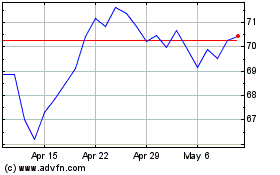By Jennifer Smith
Trucking companies anxious to hire more drivers but facing a
slim pipeline of new recruits aren't finding much to encourage them
at James Rumsey Technical Institute in Martinsburg, W.Va.
Enrollment in commercial-driving courses at the school dropped
to its lowest point in about 15 years this winter, a signal that
the industry's attempts to sell workers on truck driving haven't
gained much traction.
"Recruiters said all the schools were down this winter," said
instructor Michael Timmer, although he added that more students are
trickling in as the weather warms.
U.S. freight volumes are surging on the back of strong economic
growth, as retailers and manufacturers hire more trucks to haul
imports from seaports to distribution centers and raw materials to
factories. But the flow of new truck drivers is lagging far behind
the roaring freight market.
With unemployment at a nearly two-decade low, the downsides of
life behind the wheel are making recruitment tough. Many workers
are opting for construction or energy jobs that offer more time at
home or better pay. The trucking workforce is aging, and young
people who may want to try trucking have to wait until the are 21
years old to get an interstate commercial driver's license.
"I get a lot of guys out of high school. They come down for an
interview, I say come back and talk when you're 21," said Mr.
Timmer. "I rarely see them again."
Big-rig life can be grueling and lonesome. Truckers can spend up
to 11 hours a day behind the wheel, often bunked down in cramped
berths and subsisting on truck-stop food. The work takes a toll on
drivers' health: Almost 70% of long-haul drivers are obese,
according to a 2010 federal government survey.
Turnover at companies is high, with long-haul truckers often
hopping from one fleet to another in search of better wages or
working conditions.
There are roughly 1.67 million commercial truck drivers in the
U.S. Between 400,000 and 500,000 of those are long-haul truckers --
the toughest to recruit and retain, according to Kristen Monaco, a
researcher with the Bureau of Labor Statistics. Those figures don't
include the thousands of self-employed drivers who own their own
trucks.
The labor pool isn't growing much despite a blizzard of
help-wanted ads and inducements from trucking firms looking to
profit from the freight market rebound that began last summer. The
Commercial Vehicle Training Association, which represents driving
schools that typically train some 50,000 drivers each year,
estimates enrollment in 2017 rose by about 2% from the year
before.
The trucking sector added 5,600 jobs in February, the biggest
such jump since 2015. But companies that typically compete for
workers from the same pool as truckers hired at a faster clip:
Construction payrolls swelled by 61,000, while manufacturing gained
31,000 jobs.
The result is that carriers can't expand their fleets, and more
companies can't get their cargo moved on time. General Mills Inc.
said in an earnings call in March that its freight costs on the
spot market for truck transportation were near a 20-year high,
joining a growing lineup of retailers and manufacturers that have
pointed to higher costs and lost business from transportation
constraints.
Many trucking companies have raised pay and are offering signing
bonuses, but those efforts haven't yet gained much traction among
new recruits.
"The problem is, it's a shrinking market" for recruits, said
Michael Gerdin, chief executive of Heartland Express Inc., which
has more than 3,000 trucks. The company raised driver pay 5% last
fall, but "there are more [drivers] leaving the industry than
coming in," he said.
The average age of a for-hire long-haul trucker was 49 years old
in 2014, the most recent data available, up from 42 in 2002,
according to the American Trucking Associations, an industry
group.
Another hurdle: people seeking commercial licenses generally
have to pay for their own training, which can cost anywhere from
$2,000 to $8,000, or tie themselves to a trucking fleet that
operates its own schools or reimburses tuition for drivers who
commit to staying on for a certain period. Some financial aid is
available through federal programs.
Transportation research firm FTR estimates carriers overall will
add about 50,000 drivers in 2018. But the industry will need to add
between 150,000 and 200,000 drivers over the next year and a half
to replace people leaving trucking and to meet new demand, the firm
says.
About 40% of student hires at Covenant Transportation Group
Inc., a Chattanooga, Tenn.-based truckload carrier, leave before
completing three months on the job, said Rob Hatchett, the
company's vice president of communications and recruiting. "Until
they get in the truck and do it, they don't really know," Mr.
Hatchett said. "Experienced drivers, they know what they're getting
into."
(END) Dow Jones Newswires
April 03, 2018 08:14 ET (12:14 GMT)
Copyright (c) 2018 Dow Jones & Company, Inc.
General Mills (NYSE:GIS)
Historical Stock Chart
From Aug 2024 to Sep 2024

General Mills (NYSE:GIS)
Historical Stock Chart
From Sep 2023 to Sep 2024
